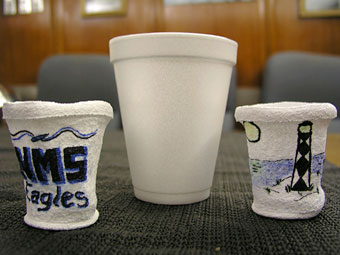

 | |||||||||
|
|
Journals 2006/2007Miriam Sutton
August 27, 2006 AM Location: Nain Bank (57° 05' 45.11" N, 57° 08' 35.56" W) Today was the last day of coring and everyone decided to take advantage of a unique opportunity available to us at 2500 meters. None of the scientists or crew knew the technical name for the phenomenon we were all so excited about experiencing. But, several of us knew the accepted procedure: Color or write on a Styrofoam cup, place it in an onion bag, secure it to the piston core, and send it to the bottom. Twenty-five hundred meters down into the deep dark depths of the ocean a strange phenomenon occurs to Styrofoam, reducing its size by half (or more). (See Styrofoam Cup photo below.)
Why does this happen? What causes the cup to shrink? The shrinkage, or compression, created in this experiment is caused by the strange relationship between the cup and the sea. The Cup: Styrofoam manufacturers use air (a gas) to expand the volume of the Styrofoam material. This results in a lightweight cup that is sturdy and is also an insulator, which is helpful in keeping your hot beverages hot or your cold beverages cold. At sea level, the cup would simply float on the surface because the surrounding pressure is equivalent to 1 atmosphere of pressure, or 1 atm. One atmosphere exerts a pressure of 14.7 lbs. per square inch. This is the pressure we are accustomed to at sea level. The Sea: The pressure increases by 1 atmosphere for every 10 meters increased in depth. This increase in pressure is caused by the accumulation of water molecules as you go deeper in the ocean. Liquid molecules pack more closely together than gas molecules, thereby making seawater heavier by volume. While the pressure at sea level is equivalent to 1 atmosphere, the pressure exerted at 1000 meters is equivalent to 10 atmospheres, or 147 pounds of pressure per square inch. For our experiment, the amount of pressure exerted on the Styrofoam cups was 25 times greater than the pressure exerted at sea level. The Cup vs. The Sea: The result of all this pressure is that the gas molecules are forced out of the Styrofoam material. With the gas molecules gone, the solid molecules are compressed closer together causing the cup to shrink in size. Today's Activity: The crew of the CCGS Hudson secured a bag of Styrofoam cups to the piston core this morning. The core was lowered to the seafloor at 2500 meters. If the atmospheric pressure increases 14.7 pounds/square inch for every 10 meters of ocean depth, how many pounds of pressure per square inch were exerted on the cups at 2500 meters of depth? Word of the Day: Insulator REMINDER: Record today's Sea Surface Temperature (SST) and the Air Temperature on the data table you created from the August 05 journal entry. |
||||||||
